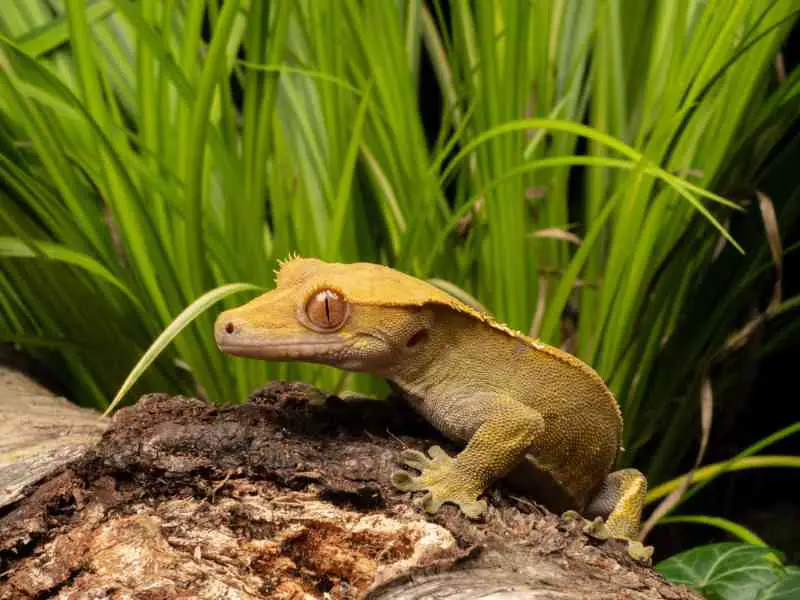Can Crested and Gargoyle Geckos Live Together?

Yes, they can! However, there are a few things to remember when housing them together.
Contents
How Are They Similar?
Both crested and gargoyle geckos have an average captivity lifespan of up to 20 years. They are the same in size and very similar in energy levels. However, the crested gecko has slightly more activity than gargoyles.
Both geckos love varied diets, including insects, vegetables, and fruit. Insects are not required for a healthy diet, but they prefer them.
Both are easy to tame and easy to handle. In addition, they both need a large, decent-sized tank environment to allow for physical activity. However, crested geckos have a higher temperature and humidity requirement than gargoyle geckos.
Overall, both geckos are great for new pet owners.
Can They Breed?
Yes, they can. However, you’ll want to ensure that both types of geckos are ready for this.
The female should be at least 12 months old, and the male should be ten months old. The female should weigh 40+ grams before mating, and males should weigh 30+ grams. You’ll also want to ensure that the geckos are around the same size and are eating healthy diets.
If they do not meet these requirements, you should wait to introduce them until they do.
Can They Eat The Same Food?
Yes, they can. The dietary needs of both crested and gargoyle geckos are very similar. Both prefer insects with calcium and vitamin D3 powder sprinkled on top. In addition, fruits and vegetable mixes are a part of their diet.
Because of the similarities, they can definitely eat the same food.
Do I Need A Bigger Tank?
Absolutely. Both crested and gargoyle geckos are active and thrive in a tank environment that allows them to move around. When there are two of them, it’s best to have an even larger environment to allow for this freedom.
The more room to roam, the happier your gecko will be.
Do I Need to Change Anything In The Tank Environment?
Gargoyle and crested geckos have slightly different tank needs regarding the environment and temperatures.
You’ll want to keep your tank warmer and with higher humidity. The crested gecko needs more warmth and humidity than the gargoyle gecko. However, the gargoyle gecko can handle the warmth, so finding a temperature and humidity that fits both needs is ideal.
For your reference, crested geckos need temperatures between 82 and 85 degrees Fahrenheit during the day and between 65 and 72 degrees at night. Gargoyle geckos need a temperature between 78 and 82 degrees during the day and low 60s or 70s at night.
The ideal temperature for the tank would be 82 degrees during the day and around 70 degrees at night.
In addition, crested geckos thrive in humidity between 60% and 80%, while gargoyle geckos thrive between 50% and 70%.
The ideal humidity level would be about 65% for both.
Can Two Males Live Together?
Absolutely not. Two males in one enclosure will cause fighting for dominance, especially if females are present.
This is especially true if you have two male gargoyle geckos in the tank as well, but is also applicable for one male crested gecko and one male gargoyle gecko.
You can have more than two geckos in the same tank if only one is male.
More than one male should not be in the same enclosure for safety reasons.
How Should I Introduce Them To Each Other?
When introducing the two geckos, it’s important to do so a few hours before nighttime. This will allow for lower energy levels and a better greeting between the two.
When you place the geckos in the tank together, put them on opposite sides. Allow them to warm up to each other naturally. They will slowly move toward each other, and they mustn’t be interrupted or taken out of the tank before their first interaction.
They will often mate right after their first encounter; however, if you notice any aggression during this, you need to separate them. After separation, repeat the greeting process of placing them across the way from each other and let them try again.
Be sure to check that the aggression signs are clear. Sometimes, it’s normal for the male to bite up and down the female’s sides during mating, which is okay. Don’t interfere. But if you see any signs of aggression, you may separate the two for their safety.
If aggression continues after a few separations, you may need to consider separate enclosures. However, most times, they will get along just fine.




